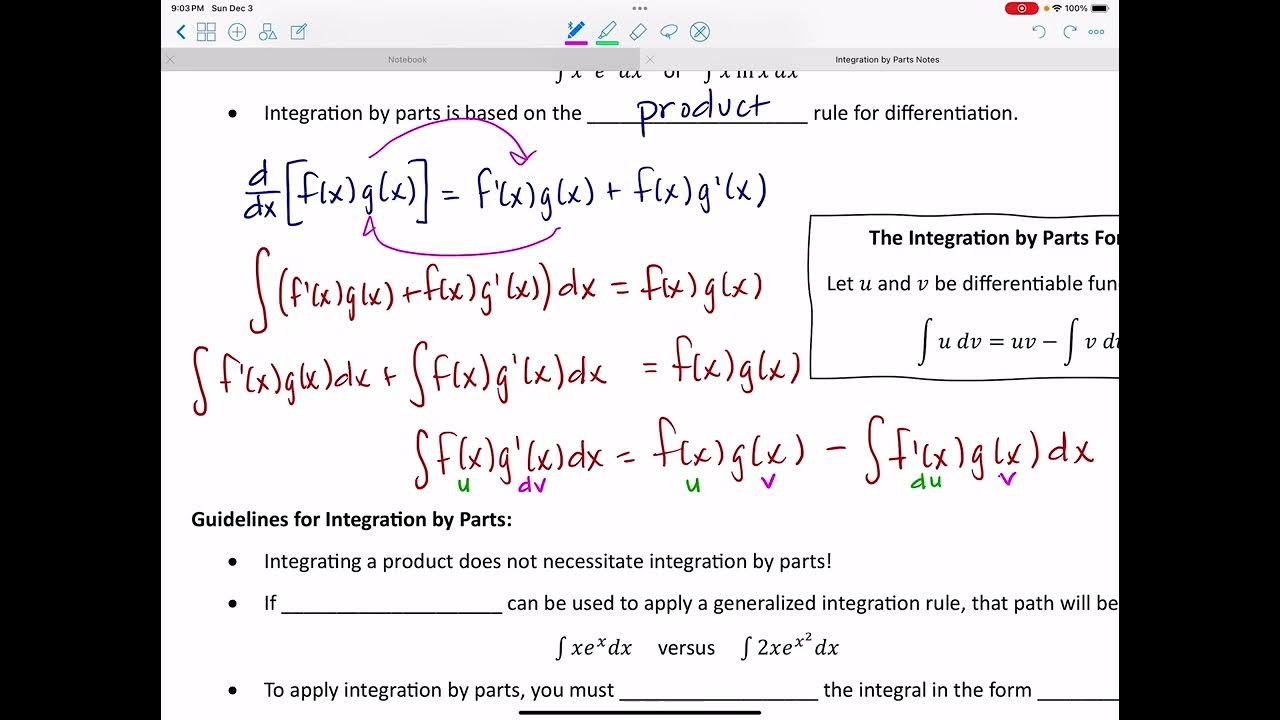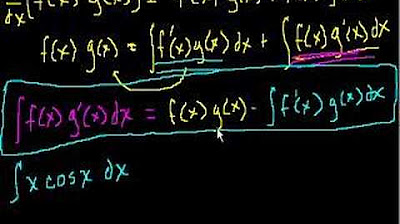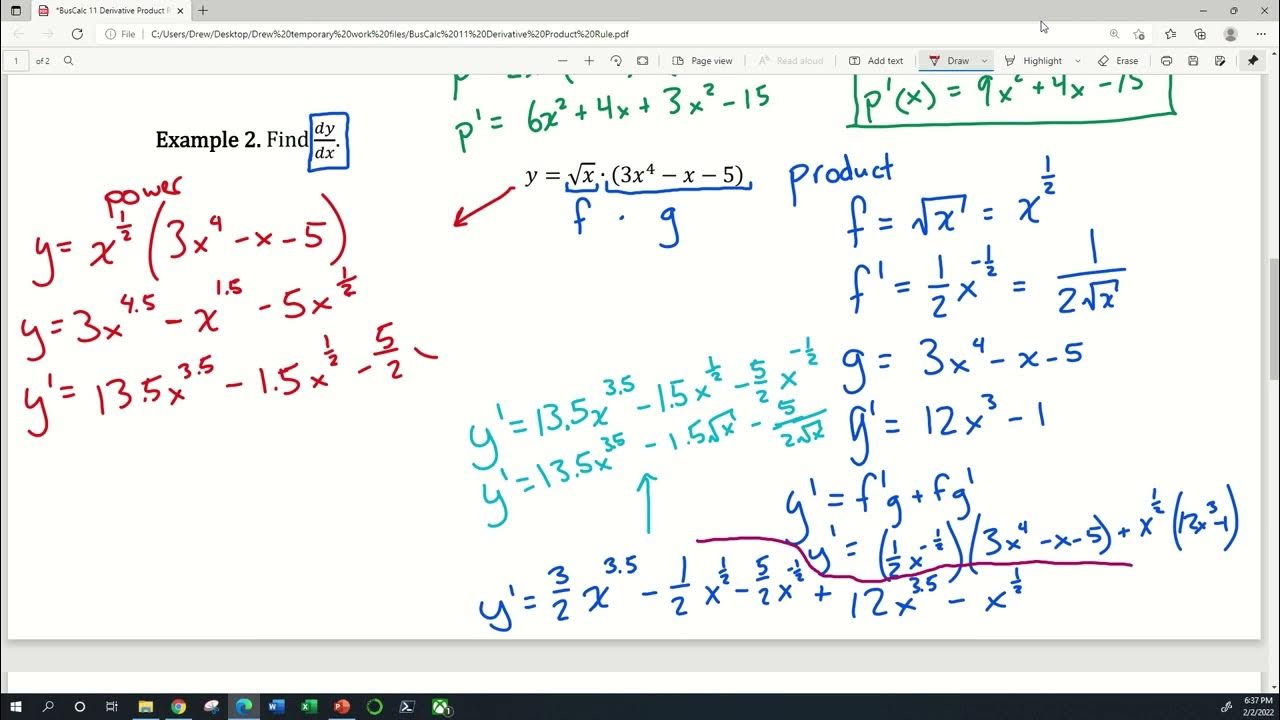Integration by parts intro | AP Calculus BC | Khan Academy
TLDRThis video script delves into the concept of integration by parts, which is derived from the product rule. It explains how to take the derivative of a product of two functions and then find its antiderivative. The process involves applying the product rule in reverse, integrating the derivative of one function times the other function, and then solving for the desired integral. This method is showcased as a powerful tool for simplifying complex integrals, which will be further demonstrated in the subsequent video.
Takeaways
- 📚 The video begins with a review of the product rule, a fundamental concept in calculus.
- 🔄 The product rule is key to understanding the derivation of the integration by parts formula.
- 🅿️ The integration by parts formula can be considered the inverse of the product rule.
- 🌟 The script demonstrates how to express a function as a product of two other functions, f(x)g(x).
- 📈 The derivative of the product f(x)g(x) is detailed, following the product rule formula.
- 🔄 The process of taking the antiderivative of both sides of the equation is explained.
- 🎯 The goal is to solve for the integral of the product of two functions, leading to the integration by parts formula.
- ➖ The solution involves subtracting the antiderivative of the first function times the derivative of the second from the product of the functions.
- 📝 The final form of the integration by parts formula is presented in a traditional textbook format.
- 🤔 The script acknowledges the potential initial skepticism about the utility of the integration by parts formula.
- 🚀 The next video will show how the integration by parts formula can simplify complex integrals.
Q & A
What is the main topic of the video?
-The main topic of the video is the review of the product rule and the derivation of the integration by parts formula.
How is the product rule expressed in the context of the video?
-The product rule is expressed as the derivative of a product of two functions, f(x) and g(x), which is (f'(x) * g(x)) + (f(x) * g'(x)).
What is the inverse operation of the product rule?
-The inverse operation of the product rule is the integration by parts, which helps in finding the antiderivative of a product of two functions.
How does the video demonstrate the transition from the product rule to integration by parts?
-The video demonstrates this by taking the antiderivative of both sides of the product rule equation, leading to the integration by parts formula.
What is the general form of the integration by parts formula?
-The general form of the integration by parts formula is ∫f(x)g'(x)dx = f(x)g(x) - ∫f'(x)g(x)dx.
Why might the integration by parts formula be useful in calculus?
-The integration by parts formula is useful because it can simplify the process of finding antiderivatives for products of functions, especially in complex integrals.
How does the video suggest the utility of the integration by parts formula?
-The video suggests that the integration by parts formula can simplify the process of taking antiderivatives and make it easier to handle complex integrals, as demonstrated in the next video.
What is the significance of reviewing the product rule in understanding integration by parts?
-Reviewing the product rule is significant because it provides the foundation for understanding how the integration by parts formula works, as it is derived from the product rule.
What is the role of the antiderivative in deriving the integration by parts formula?
-The antiderivative plays a crucial role in deriving the integration by parts formula, as it is applied to both sides of the product rule equation to lead to the new formula.
How does the video emphasize the importance of the integration by parts formula?
-The video emphasizes the importance of the integration by parts formula by showing that it can be a powerful tool for simplifying complex integrals and making calculus problems more manageable.
What is the step-by-step process shown in the video for deriving the integration by parts formula?
-The step-by-step process includes: (1) applying the product rule to a function expressed as a product of two other functions, (2) taking the antiderivative of both sides of the resulting equation, (3) solving for the specific part of the equation that involves the product of the first function and the derivative of the second, and (4) rearranging the formula to match the traditional textbook form.
Outlines
📚 Introduction to Integration by Parts
This paragraph introduces the concept of integration by parts, which is derived from the product rule. It explains that if a function f(x) can be expressed as a product of two other functions, then the derivative of this product can be found using the product rule. The paragraph then proceeds to illustrate how to take the antiderivative of both sides of the resulting equation, leading to the formula for integration by parts. The explanation emphasizes the utility of this method in simplifying complex integrals, even though it may still involve an integral within the process.
Mindmap
Keywords
💡Integration by Parts
💡Product Rule
💡Derivative
💡Antiderivative
💡f(x) and g(x)
💡f'(x) and g'(x)
💡Constant
💡Review
💡Simplify
💡Inverse
💡Complex Integrals
Highlights
Reviewing the product rule, a fundamental concept in calculus.
Deriving the integration by parts formula, an essential technique for solving complex integrals.
Expressing a function as a product of two other functions, f(x) = f(x) * g(x), to apply the product rule.
Applying the derivative operator to a product of functions, resulting in a sum of two terms.
Taking the antiderivative of both sides of the product rule equation to transition towards integration by parts.
Ignoring the constant when taking the antiderivative, as it does not affect the final result.
Solving for the integral of the product of functions, which is the core of integration by parts.
Subtracting the second term from both sides of the equation to isolate the desired integral.
Expressing the integration by parts formula in a clear and traditional textbook format.
Understanding that the integration by parts formula can be applied to integrals of the form f(x) times the derivative of another function.
Recognizing that the integration by parts technique can simplify complex integrals, even when an integral remains.
The video serves as a review of foundational calculus concepts, suitable for strengthening understanding.
The integration by parts method can be viewed as the inverse of the product rule, providing a new perspective.
The process of moving from the product rule to integration by parts demonstrates the interconnectedness of calculus concepts.
The video promises to show in the next installment how integration by parts can significantly simplify complex integrals.
Transcripts
5.0 / 5 (0 votes)
Thanks for rating:





